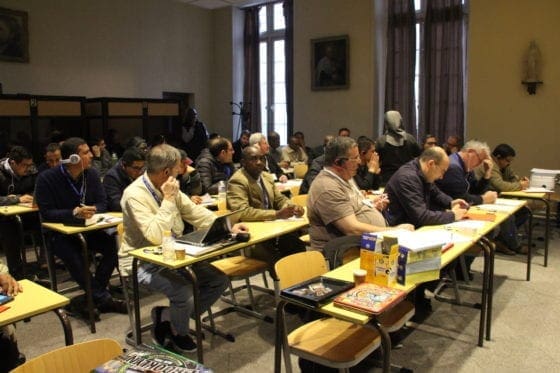From Monday 19 November through Friday 30 November 2018 the International Formation Center (CIF) gathered about 60 Vincentian confreres, representing 90 countries from around the world, at the Motherhouse in Paris, to share and learn how they might better create and promote a culture of vocations in the Congregation of the Mission worldwide. All of the men who gathered were engaged at some level with vocation promotion.
Day 2: Tuesday 20 November
Sister Therese Read, SCSJA of the Sisters of Charity of St. Jeanne Antide Thouret presented on the topic of the digital world and its influence on vocation promotion. She spoke of the new vocation situation and the youth paradigm, the implications and challenges of the digital media situation in the world today.
The digital world presumes a transparent society and world at large; this is the world that youth live in today; they live in a world of “big data.” The internet modifies and creates a different sense of community from local to global. Youth live in their individual rooms and yet are connected “to the world” through the internet. Oddly, this results in a kind of isolation the youth experience, feeling isolated from each other since there is less personal, individual contact. There isn’t much reflection in their lives but they “live in the moment.” They live in a virtual world and often don’t know how to live in a real world. Youth are hyper connected to each other but often are disconnected from the real world. They are constantly looking for the new, the different, the “right now.” Youth question the world of their elders who live in a structured world. The world of the youth is one of personal expression and not of personal reflection.
To spread the word of God we must know how the internet functions since the internet and digital media is the youth’s way of communication. The recent Synod 2018 on Young People, the Faith, and Vocational Discernment examines living in a culture that is profoundly influenced by the digital world. The web can greatly help communication and the distribution of large amounts of information. It can help reach individuals who are in venerable situations. But the web also has a dark side. It is a place where people can be engaged with life but it is also a place where individuals can be isolated and violated; cyber bullying occurs and abuse of various kinds can occur. There are both opportunities, challenges and hazards.
Group members shared many experiences of both the difficulties and positive experiences of working with digital media. How can we use the internet to listen to youth, to find out their needs and concerns? How can vocation directors best use the internet to evangelize, to help the discernment process, to accompany the spiritual growth of youth, and to foster vocations to the Congregation?
Fr. Rolando Gutiérrez, C.M. from Costa Rica led the group in a video conference/presentation of the statistical situation of the Congregation in the recent past and at present. Some important statistics are as follows: Today we have 29 provinces, 4 vice-provinces, 8 regions and 1 house that is dependent on the Curia (Holland). We have 9 international missions ad gentes. In the year 2000 we had 557 confrere houses in the world and in 2018 there are 497 houses. We have 31 bishops, 2876 priests, 56 deacons, 28 seminarians who are incorporated, and 126 brothers for a total of 3117 confreres. In 2000 we were 3343 members and today there are 3117 confreres. In 17 years we have lost 8% of our personnel with 60 fewer houses and 226 fewer confreres. On average we lose 17 confreres each year. In 2017 we had 3143 incorporated members, 548 admitted members (those who have entered the internal seminary), and 616 aspirants (pre-internal seminary). Between 2010 and 2016 there were 391 confreres incorporated into the Congregation, the majority coming from Asia Pacific, Latin-America, Africa and Madagascar. In 2000 in Africa there were 40 houses and in 2017 there were 59. In America in 2000 there were 211 houses, 1242 incorporated members and 164 admitted members; in 2017 there were 183 houses, 1016 incorporated and 103 admitted confreres. In Oceania in 2000 there were 8 houses, 62 incorporated and 11 admitted members; in 2017 there were 6 houses, 40 incorporated members and 5 admitted members. The Congregation is growing in the southern regions of the world.
Fr. Rolando talked about three groups of confreres: (1) those who are present but are absent: they are members but who create problems and move from house to house trying to find a home; (2) confreres who are absent from the Congregation: some with permission of the superior general, some who are absent without permission, those who are in the process of being incardinated into a diocese, and those who are seeking dispensation from the clerical state. In 2018 160 confreres are absent: 18 have permission to be absent for 1 year, 10 have permission of the superior general, 109 are absent without permission, 17 are seeking incardination into a diocese and 6 are special cases; and (3) those who have left the Congregation. The reasons confreres give for leaving: problems with their family, they will have more freedom if they leave, the Congregation is lacking in ministries, there were difficulties living in community, they didn’t like criticisms for the work they were doing, etc. Between 2010-16 133 have left the Congregation, about 22 per year.
Works of the Congregation worldwide: we have 975 confreres working in parishes; 345 retired, sick or convalescing; 274 in seminaries and formation of the clergy; 227 mission ad gentes; 175 in schools; 174 are absent; 141 in administration; 131 in popular missions; 123 in other ministries; and 144 are in hospitals, associations, military, etc.
The C.M. personnel catalogue is available online.
Jim Osendorf, C.M.
US Western Province


